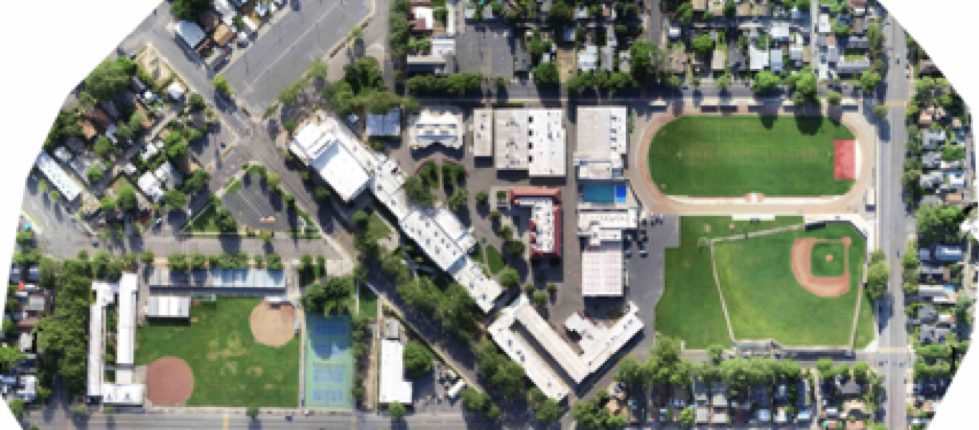By Andrew Maximow, Chief Drone Officer
In the past, we’ve discussed techniques and best practices necessary for precision mapping projects requiring a high degree of absolute accuracy. Not all clients require that level of accuracy, so different tools and techniques are used to create the deliverables. At Firmatek, it’s our job to serve as trusted advisors. We help our clients understand their deliverables so they can better understand their operational insights. A one-size-fits-all solution in our industry isn’t practical, so we work with our clients to determine the best tool for precise and efficient data collection and processing.
For example, our clients in the facilities management industry require a different level of precision than those in other industries. A facilities management client requires aerial orthos for a portfolio of many properties that vary in size from small to large. The objective is obtaining a real-time qualitative assessment of a property via hi-resolution aerial imagery. Then, by prioritizing maintenance projects, our clients can proactively dispatch maintenance personnel for remediation and track progress over time. Bottom line, this calls for high volume, medium accuracy, and highly repeatable drone-operations with lots of opportunity to automate and focus efforts on analytics that elevate business intelligence for our clients.
A typical project may require periodic data collection with travel time between sites. In this scenario, there is an opportunity to increase efficiency, streamline workflow by taking advantage of downtime, and minimize time-consuming activities such as uploading photos over a slow Internet connection.
In this piece, I discuss and compare the traditional way of processing photos along with two faster and more efficient methods that save time, processing steps, and resources. All three methods have their positive attributes, however, all of them can be improved with new features and streamlining. I also describe what an optimal workflow could be. I hope our hardware and software partners at DJI, Pix4D are listening!
Traditional Processing Flow
The traditional way goes something like this:
- Plan/fly the mission and collect the photos using an app like DJI GS Pro, Maps Made Easy, or Pix4D Capture. It’s worth noting that one major benefit of the DJI GS Pro app is that one can inges .kmz files that are provided by our clients, indicating the boundaries of the sites to be mapped.
- Transfer the photos from the SD card to a desktop computer.
- Depending on your organization, you may need to upload the photos to the data processing center where the Pix4D software is located.
- Process the photos on your desktop using Pix4D Desktop or Agisoft PhotoScan software. Wait a long time…*yawn*…and voila an ortho is generated.
- Drop, crop, chop the ortho into whatever end product and deliverable requested by the client.
[av_image src=’https://firmatek.com/wp-content/uploads/2019/08/Picture3-797×430.png’ attachment=’6298′ attachment_size=’featured’ align=’center’ styling=” hover=” link=” target=” caption=” font_size=” appearance=” overlay_opacity=’0.4′ overlay_color=’#000000′ overlay_text_color=’#ffffff’ animation=’no-animation’ admin_preview_bg=”][/av_image]
Often times at Firmatek, this traditional process requires high-speed Internet connection and multiple resources with a hand-off between a Field Technician, to our Data Processing Department in our HQ office in San Antonio. Turnaround-times are typically within 48 hours, but requires multiple steps and often, error prone.
Pix4Cloud
Pix4D offers another way with faster and more efficient methods to plan, capture, and process the data:
- Plan/fly the mission and collect the photos using Pix4D Capture.
- Upon landing Pix4D Capture automatically transfers the photos from your drone (SD card) to your smartphone/tablet (onboard memory) and then to Pix4D Cloud (their basic photo processing product offering that is cloud based) via your smartphone’s LTE connection or via WiFi, when available.
- Pix4Cloud notifies you when the orthos are complete.
This method offers more consistency with a dramatically streamlined workflow. However, there are several caveats worth noting. First the automatic photo transfer between the SD card on the drone and the smartphone/tablet takes time and valuable battery life at both ends, significantly limiting your drone “air time” flight time collecting data. This works well for smaller sites requiring less than 150 photos that can easily be transferred and uploaded to Pix4D Cloud during travel time between sites. The biggest caveat is the significantly limited functionality of Pix4D Cloud. As of this writing, the only output is a GeoTIFF. If you need to perform some other analysis, or some other file type output, such as .jpgs, you need to download the GeoTIFF files from Pix4D and process Pix4D Desktop or some other software – major inconvenience! (Hello, Pix4D, I hope you are listening!).
Pix4D Fields
Most recently, I had the opportunity to test an even better approach using yet another product from Pix4d called Pix4D Fields. This app is loaded with a ton of features and functionality geared towards the Agriculture market. It also has a rapid photo processing capability, not yet found in other products. I decided to try it out for our Facilities Maintenance use-case. It works on Apple Mac and PC desktop machines. The workflow is super simple:
- Plan/fly the mission and collect the photos using the Pix4D Capture app.
- Transfer the photos from the SD card to a desktop computer.
- Import the photos into Fields and click on Process.
- The output is a geoTIFF, however, a native app on the Mac such as Preview can be used to convert to a .jpg format.
Boom done!

I was able to process a fairly large site (over 500 photos) in under 4 minutes, including creating the final .jpg deliverable. The results of the rapid photo processing method are comparable in quality to the traditional way of processing that takes much longer.
This represents a tremendous improvement in overall workflow. However, there’s room for improvement. In our view, the ultimate workflow would combine the last two methods together as follows:
- Plan/fly the mission and collect the photos using the Pix4D Capture app.
- Pix4D Capture automatically transfers photos from the drone (SD card) to the local desktop computer running Fields.
- With a super simple script, Fields imports all the photos and automatically processes the photos resulting in the desired format and folder structure.
- Simple, plug-in AI routines were available to further process and calculate areas, and recognize anomalies such as cracks in the pavement and landscaping that needs attention.
The real benefit for the clients is the actionable information derived from analytics applied to the aerial imagery. For example, the exact area of the grass fields can be automatically calculated, added to RFPs, and submitted as part of a more accurate and efficient bidding process by landscape contractors.
We’ve Come A Long Way
Collecting and processing data is getting easier as technology advances. The tools we have today make it much easier to get the insights you need to improve your operational efficiencies and make your operation more profitable. By comparing traditional processing to new and improved methods, your team can better decide what works best for your optimal workflow.
However, remember the tool itself will not solve your problems. You need to get more than data from your tools. You need to use the insights that you receive. It’s about your business intelligence. It’s about using that business intelligence in your operation. That is what is going to make the difference for you.
While the technology has come a long way and made it much easier to get insights from data that can increase your business intelligence and help you make better business decisions, there are still a lot of improvements to be made. At Firmatek, we are always looking for new and better solutions to implement in our team and give to our clients. We are excited about where the industry is going and what we will see next from some of these hardware and software partners.


